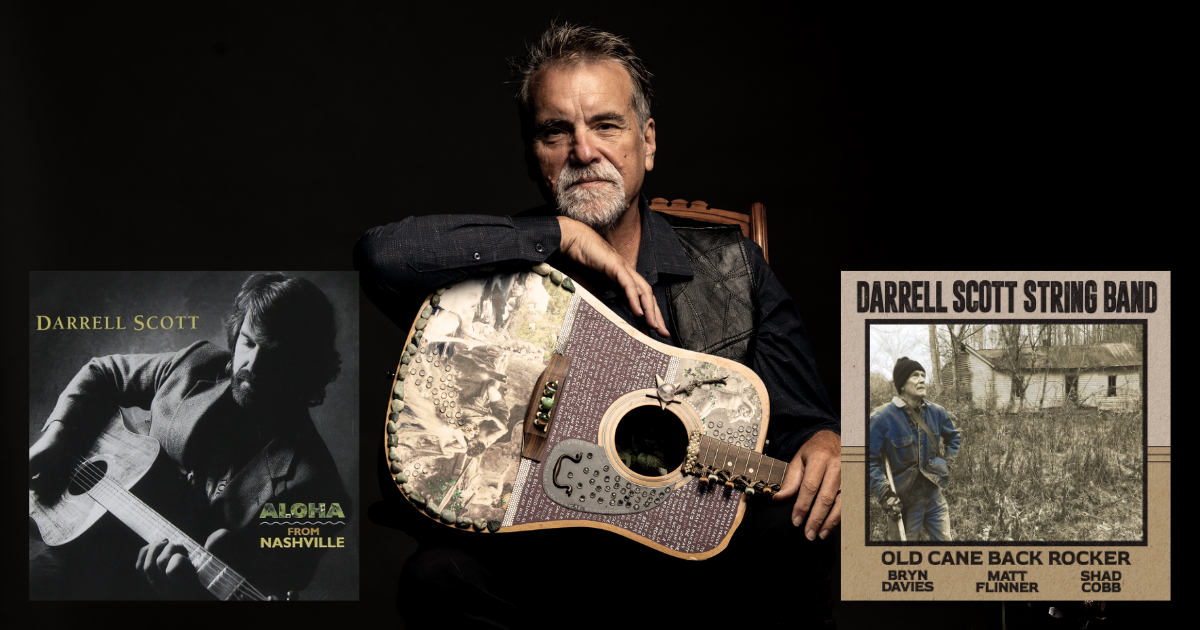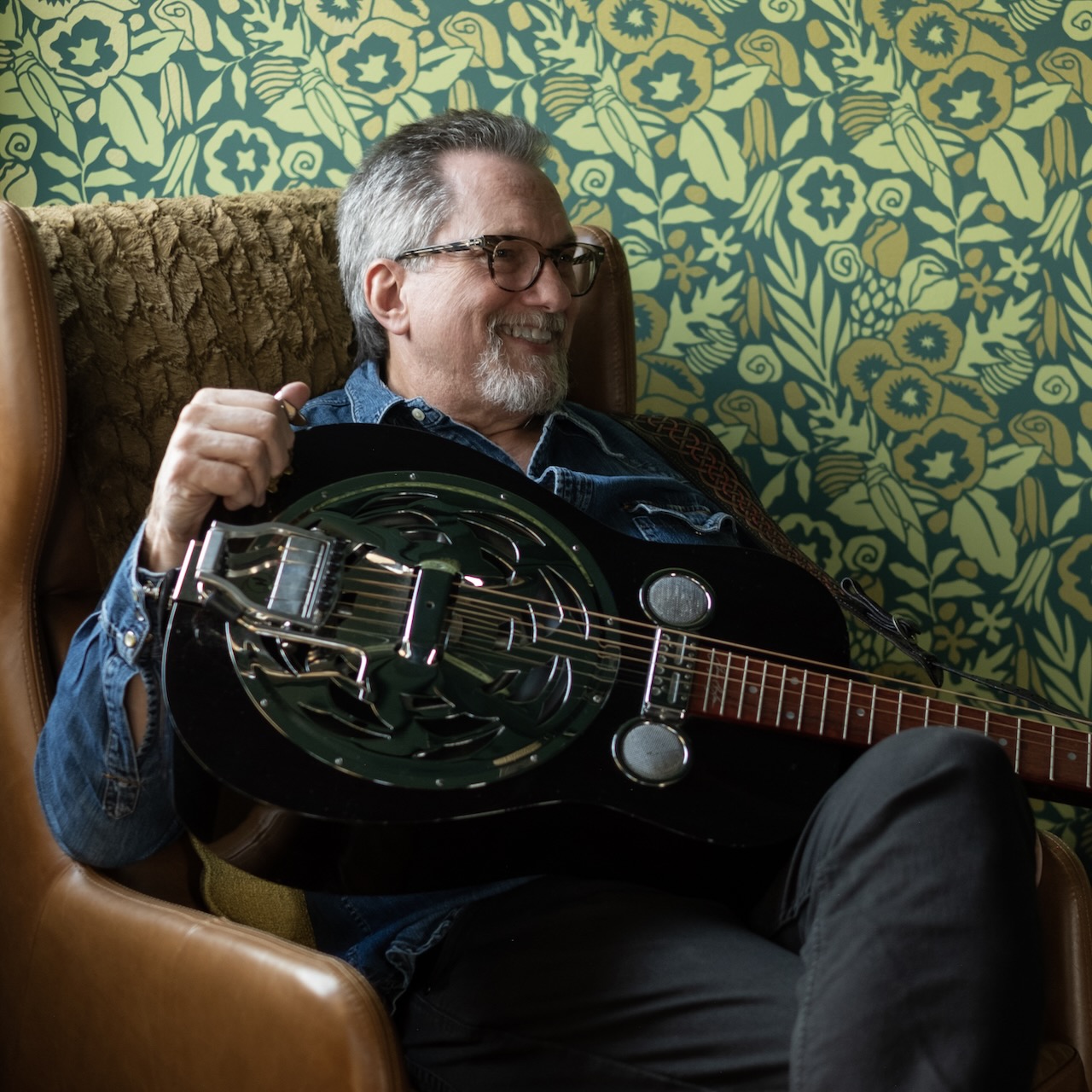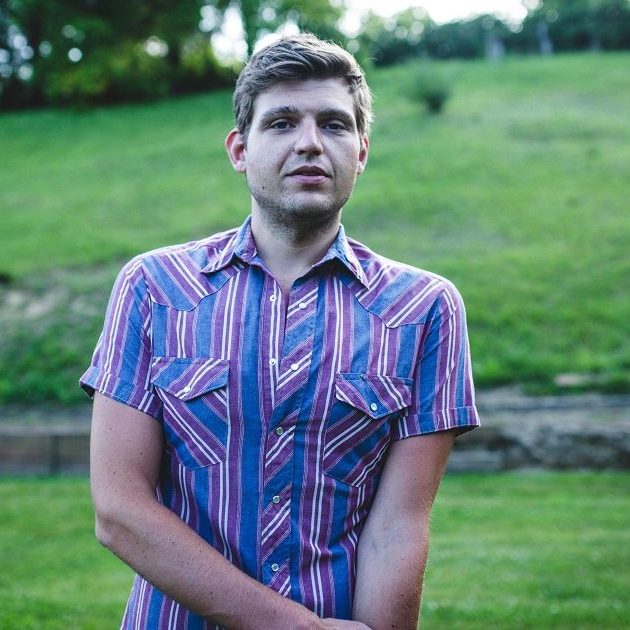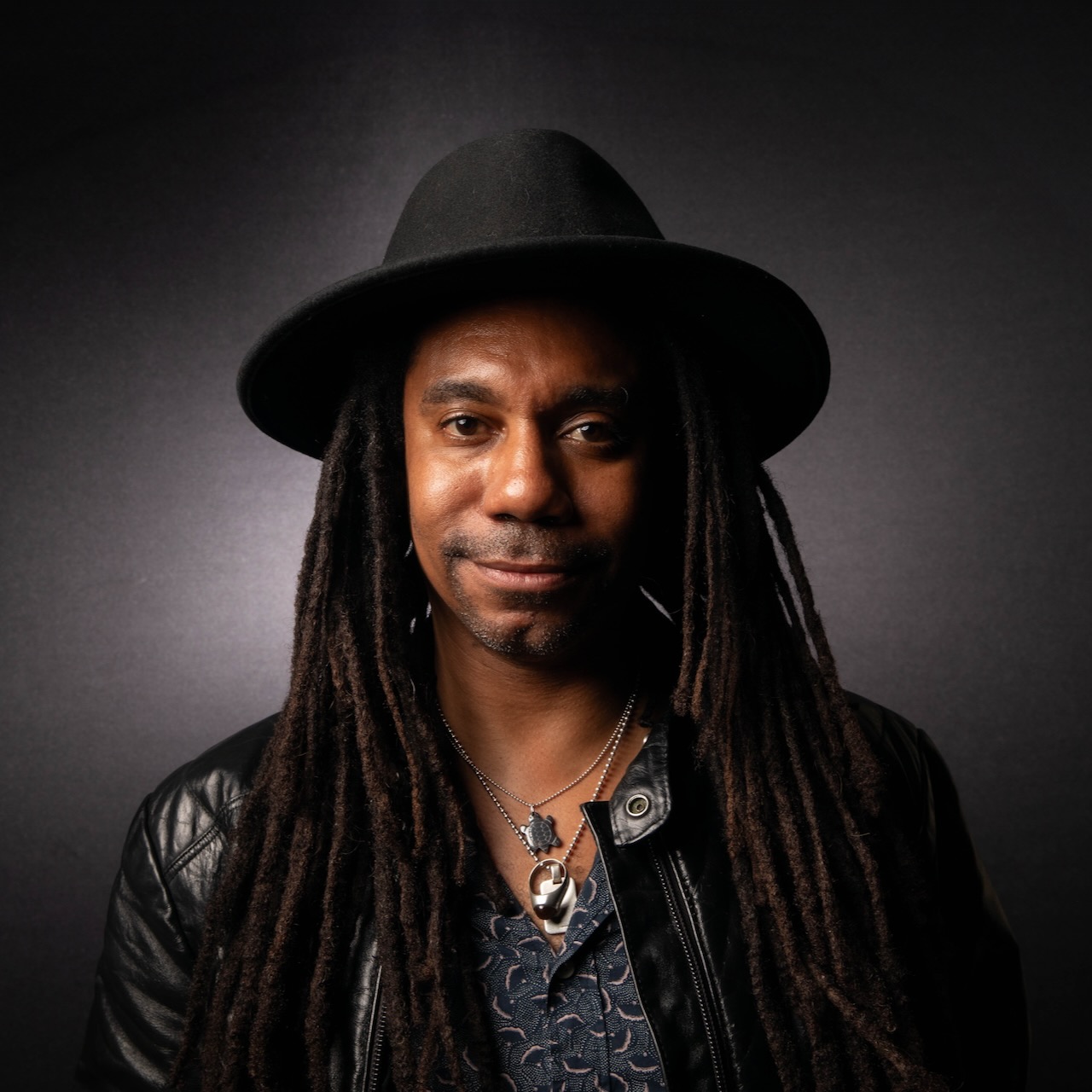For a musician that could easily play every instrument in a standard bluegrass lineup – plus dozens more – it’s remarkable that Darrell Scott put out a post-pandemic record, Old Cane Back Rocker, that decidedly features a band. A picker’s picker and a songwriter’s songwriter, Scott has in the past recorded and released albums that feature other players only sparsely, fleshed out nearly entirely by his own playing. But this time, he wanted to feature his string band.
This wasn’t a post-pandemic realization either or a discovery brought on by the existential crises of the early pandemic, when communal music seemed like a far distant memory. No, Old Cane Back Rocker was actually tracked in 2019. COVID-19 was not the impetus for this collectively-created record, but rather the pickers themselves: Bryn Davies on bass, Matt Flinner on mandolin and banjo, and Shad Cobb on fiddle each inspired this new release, its track list, and its “out of many, one” approach.
For avid fans of this hit songwriter and country music renaissance man, Old Cane Back Rocker will feel like a return of sorts, a homecoming that reminds of many shows at the Station Inn and performances at bluegrass camps and festivals around the country. But, the album is even more fascinating and engaging when contrasted with Scott’s entire catalog, which showcases a diverse and circuitous lineup of production styles, genres and musical aesthetics.
For a new edition of First & Latest, we put Scott’s latest, Old Cane Back Rocker, up against his first release, Aloha From Nashville. As it happens, there’s a recording of Scott’s Travis Tritt-recorded hit, “It’s a Great Day to Be Alive” on each album, making for the perfect starting point for our phone conversation.
When you first recorded “It’s a Great Day to Be Alive” in the ‘90s, did you expect it would have this longevity? Did you have a feeling you’d still be recording it and performing it or did you think it would be the hit that it’s been?
Darrell Scott: No, hits are hard to distinguish, when you just hear the song – at least for me.
I think a hit has a lot more to do with the business, to make a hit, and it’s not the songwriter. It’s everything that follows after the songwriter. It’s the label. It’s the management. It’s the business connectivity, the promotion, the radio – all that has nothing to do with the songwriter. Zero. I remember saying one time, “A hit is that thing you hear a thousand times.” Repetition has a lot to do with a hit. It’s almost obvious.
Here’s one of the ironies. That song had been recorded three other times on major labels, but was never released before Travis Tritt got it. So tell me this, since it was a hit, why would three acts lose their deal [and not make it to release] with a hit? You see what I’m talking about? What made it a hit was the business machine that makes hits. A song is written by a songwriter. But a hit is made by the powers that be, after the fact.
In my case with that song, I had hurt my back, so I had to be on my back for a week. I couldn’t move, I couldn’t drive, I couldn’t go to sessions. I had to cancel my entire week so that I could lie on the floor, because I couldn’t do nothing else. Honestly, I couldn’t even sit up. After 6 or 7 days when I could [finally] sit up, I was literally just heating rice in a microwave – and considering making soup. Just sitting at the table, which I hadn’t done all week. It was the most blessed thing to do such simple things. And that’s where the song came from.
I wonder what made you want to do another version of that song this time around, with a string band? Because this is a song you’ve recorded and put out in quite a few manifestations.
DS: There’s one really simple answer for that. We recorded this album in August of 2019. In September of 2019, I’d heard two or three months in advance that a cornfield, a corn maze – like those pumpkin farms and apple pickings and that style of thing. There’s one north of Nashville that I heard was going to put my image in their corn maze. They cut my image and then the words, “It’s a great day to be alive” in their corn maze.
I thought, you know what? That, I can’t pass that one up. We’re going to have to make a video of that, and of us doing that song, rather than just lip-syncing to the one from ‘95 – which is actually when I recorded it. Wait, maybe even ‘94, but somewhere way back there. Instead of using that track, it was like, “Hey, I’m recording a string band album. I’m just going to put this in the string band’s hands and we’ll throw it down.”
I think we premiered that video back in the day! Well, the song certainly does beg the question: Does “a great day to be alive” look the same to you now as it did back then? Or, what does “a great day to be alive” look like to you now?
DS: Man, anything that makes you grateful, is a great day to be alive.
If you look at that song, there’s two things I notice in that song. First of all, the things that this person is grateful for are simple things like rice in a microwave, making some soup. They’re pondering, “Hey, I know it’s hard out there in the world, but today’s a good day, and tomorrow may not be.”
It’s just taking that moment, when you realize, “Hey, it is a great day to be alive. I am glad to be alive.” There’s no shame in saying such a thing. And that’s still the case. You know, that wasn’t just in 1994 or ‘95 or ‘97. Any day that you can feel that way is a great day.
You have this uncanny ability to take your listeners into a small, tiny moment like that, a split second moment of gratitude or of grief or of just big feelings and turn it into this whole big song. And what I’m thinking of now is “Inauguration Day” / “The World Is Too Much With Me.” And I’m so glad that ended up on the new record, because I went back to that Facebook video of that song, dozens of times after I first saw it.
DS: I’ve alluded to it so far in our talk, but songs have a life of their own, and they have a timing of their own, and they don’t have a shelf life or preservatives. You know, almost anything’ll start showing mold in about three to four days here in Tennessee. And songs don’t have that kind of shortness.
I try to gravitate towards songs. On a good day or night, to have a song that’s timeless is the goal for me. One that doesn’t just burn out in the second listening or in three months or something like that. That’s what I try to go for. I’m trying to see a bigger picture than, “So-and-so will like this song” while I’m writing it. “Oh, my publisher will like this” or, “I’m going to pitch this to so-and-so.” If you’re thinking that while writing a song, you just sold the song down the river. You don’t have that song any longer, you have a commodity.
I’m not a commodities writer, I’m a songwriter. From an experiential point of view. So, “Inauguration Day” is simply how I felt on inauguration day.
Well, and I felt myself returning to that song over and over. Even though it’s a very specific and very topical song, the repeated line, “The world is too much with me, too much today,” it just feels like such a mantra.
DS: Right? Because some could feel the same way about– uh-oh, I’m blanking on the current president… Biden! But see, some people could feel that about any inauguration day, the day that Biden got in or the day any other president got in and that’s fine.
But I absolutely wrote it on Trump’s inauguration day. I couldn’t do anything else, to tell you the truth. The world was too much with me that day. All I could do was I escaped over to my dad’s cabin. I have my dad’s Kentucky cabin here on my Tennessee property, and that’s where I went. I just crawled into a hole, pretty much, but inside the cabin was a five-string guitar that’s supposed to have six. I just played it with a bar, like a Dobro thing.
I came back to the house where there was a signal [to record the video] and there was wind in the microphone and all sorts of unprofessional things. But I then recorded that song within five minutes of being back at the house, having just written the song. That’s what I do. I follow my inclination. There again, I’m not writing a hit. I’m writing from a reaction in that case, just like “It’s a Great Day to Be Alive” was a reaction to seven days of lying on a concrete floor.
It’s not my only skillset, but it shows up [in songs] like that. I’m just writing out of a need to write. I need to write. On inauguration day, I had to. I couldn’t do anything else, so I did that and that’s how it felt. It felt like the world was too much with me.
So the other two First & Latest tracks we’re here to talk about are “Title of the Song” from Aloha From Nashville and “Fried Taters” from Old Cane Back Rocker. I feel like the through line here is pretty obvious, the sense of humor that you have in your songwriting and in your music making.
DS: Right, because that’s another part [of my writing,] I do have a humorous side. I have a sarcastic side. I have a pointed, jabby way of observation, because – here’s what’s at the top of the page, above “songwriter” or “musician” and “singer” is observer. I’m first and foremost an observer. Part of that observation is being comedic or pathetic.
That whole first album of mine, Aloha From Nashville, “aloha” means hello and it means goodbye. I wasn’t sure which it was going to be, it being my first record I put out in Nashville. I took a lot of pot-shots at Nashville and the music industry within that album, and that’s why I called it Aloha From Nashville.
“Title of the Song,” it’s just a comedic song that’s so true that it’s almost doesn’t need to be said, except I went ahead and said it, you know? Writing a song about writing a title for a song, we all know the formula. It’s poking fun at that situation. The comedy is there, in both the writing and the production.
The reason I put comedy on this last record with “Fried Taters,” is it’s the same humor, it’s the same comedy. This one’s an instrumental, but I have a voiceover thing going on that’s making the snide commentary, that is kinda the same commentary as 1994 or ‘95, with “Title of the Song.” On “Fried Taters” it’s literally the words of a famous musician in jazz who really put down country music, audibly and frequently. Those are literal quotes from that person. I littered them throughout our little instrumental, to have that attitude.
Was that a tune by you? Did the melody come from you? Was that a band tune?
DS: I had the progression, that I wrote. Matt Flinner is such a great composer, who plays the mandolin and banjo in this group, he has so many records and compositions. He’s an educator, he teaches. He’s just a marvel as a composer. I knew that I could just flip [the chord progression] over to Matt. It had an A section and a B section, but that was about it. So he’s the one who put the melody to it. It’s a co write, but we never sat together with it. I did the chords and sent it off to him and he sent me back the melody and we were ready to record it.
I definitely appreciate you, more than almost anybody else, getting Matt Flinner to play banjo. He is so good on banjo.
DS: Yeah, he’s such a great banjo player and I’m so pleased that he plays it for me. I think probably, the only other time that he played banjo was in Leftover Salmon. Matt Flinner is such a great banjo player and many of us know this about him. I’m so lucky I get him to play banjo on every single gig, I mean, he may be on banjo more than he is on mandolin on our gigs. He’s a fabulous banjo player. I play banjo, too, but I know what a really great banjo player is. Matt’s got the composer ability. He’s got the band leader ability. He’s got the sideman ability, obviously the mandolin and the educator ability, but then he gets in there and and plays banjo that well.
What a lot of people think of first when they think of you is like, a one man band or that you’re a multi-instrumentalist or utility player, but clearly it was so important for you to have a band with you on this album. Why did you intentionally want to make this a collective work, rather than just hiring a band to back you up or playing it all yourself?
DS: Yeah, well, because I wanted this to be a band. I’ve played with these guys now for eight or 10 years. I don’t even know. Anytime a festival wanted me to have, in essence, a bluegrass band or bluegrass instrumentation, these are the very people I’d take. Every single one of them. We did a Live at Station Inn album and it’s the same people. If RockyGrass hired me, or Grand Targhee, or MerleFest, or something like that, this is who I would bring. But we’d never made a studio album. So I knew I had to do that.
Then the other part of it, I wanted it to be a band, but not just in the instrumentation. I want Matt to bring in a tune. I want Shad [Cobb] to bring in a tune. I want participation. I want everybody to sing harmonies, every chance we get. I very mindfully made this a band record – sound, input of songs, and stuff – because I know how to put together a solo album and all that. I’ve done it. I wanted this to be this band, because I know their abilities beyond just being sidemen.
I think bluegrass fans know that you’re a picker’s picker. But sometimes your albums, they’re so song-centered that that fact can fall to the wayside, despite the fact that you’re always improvising and using that vocabulary. So with this album and having the band right in the title, it felt like a return in some ways.
DS: Well, that’s what I wanted and why I wanted to do it with these people, it has everything to do with these exact people.
Here’s one of those ironies of our town or this music. So you what’s supposedly called a “sideman” like Shad Cobb, but Shad can lead his own band. He’s got boxes and boxes of songs and tunes. Matt Flinner has cases of songs and tunes. He used to tour with his trio and they would write a song per day, each of them. And that night they’d perform it!
This is what I’m talking about. These people, they do stuff like that. Where’s the hit making in that, you see what I mean? Just going back to that silly idea that the hit is everything. No, driving 300 miles and having a new tune that night times three people in the band, that’s news to me! Not what’s number one this week.
Photo Credit: Michael Weintrob




